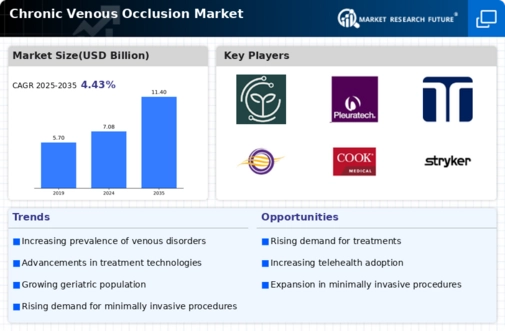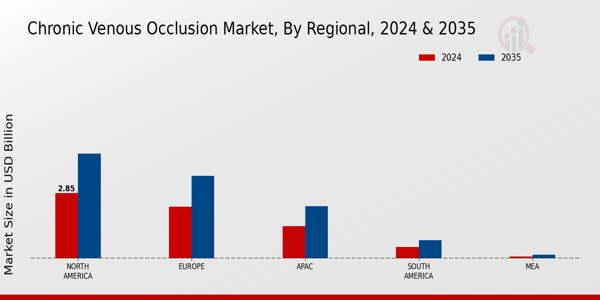Rising Healthcare Expenditure
The increase in healthcare expenditure across various regions is a significant driver of the Chronic Venous Occlusion Market. As governments and private sectors allocate more resources to healthcare, there is a corresponding rise in funding for research and development of new treatments for chronic venous diseases. This trend is particularly evident in regions where healthcare budgets are expanding, allowing for greater investment in innovative therapies and technologies. Reports indicate that healthcare spending is projected to grow at a rate of 5% annually, which could lead to enhanced access to treatment options for patients suffering from chronic venous occlusion. This influx of funding is likely to stimulate the Chronic Venous Occlusion Market, as more effective solutions become available to address the needs of patients.
Advancements in Medical Technology
Technological innovations in medical devices and treatment methodologies are significantly influencing the Chronic Venous Occlusion Market. Recent advancements, such as minimally invasive procedures and improved imaging techniques, have enhanced the diagnosis and treatment of chronic venous occlusion. For instance, the introduction of endovenous laser therapy and radiofrequency ablation has revolutionized the management of venous diseases, offering patients safer and more effective options. The market for these technologies is projected to grow, with estimates suggesting a compound annual growth rate of over 8% in the coming years. As healthcare providers increasingly adopt these advanced technologies, the Chronic Venous Occlusion Market is expected to expand, driven by the demand for more efficient and patient-friendly treatment alternatives.
Growing Focus on Preventive Healthcare
The emphasis on preventive healthcare measures is becoming increasingly relevant in the Chronic Venous Occlusion Market. As awareness of chronic venous diseases rises, healthcare systems are prioritizing prevention strategies to mitigate the risk of developing these conditions. Initiatives aimed at educating the public about lifestyle modifications, such as regular exercise and weight management, are gaining traction. This shift towards prevention is likely to reduce the incidence of chronic venous occlusion, thereby influencing market dynamics. Furthermore, healthcare providers are investing in screening programs to identify at-risk individuals early, which may lead to increased demand for preventive treatments and interventions. Consequently, the Chronic Venous Occlusion Market may experience growth as stakeholders adapt to this evolving focus on prevention.
Increased Collaboration Among Stakeholders
The growing collaboration among various stakeholders in the healthcare sector is fostering advancements in the Chronic Venous Occlusion Market. Partnerships between pharmaceutical companies, medical device manufacturers, and healthcare providers are becoming more common, aimed at enhancing treatment options and improving patient care. These collaborations often lead to the development of innovative therapies and comprehensive care models that address the complexities of chronic venous diseases. Additionally, joint efforts in clinical research and trials are likely to accelerate the introduction of new products to the market. As stakeholders work together to tackle the challenges associated with chronic venous occlusion, the Chronic Venous Occlusion Market is expected to benefit from a more integrated approach to treatment and management.
Increasing Prevalence of Chronic Venous Diseases
The rising incidence of chronic venous diseases, including chronic venous occlusion, is a primary driver of the Chronic Venous Occlusion Market. Factors such as an aging population, sedentary lifestyles, and obesity contribute to this trend. According to recent estimates, chronic venous diseases affect approximately 25% of adults, with a notable increase in cases among older individuals. This growing patient population necessitates enhanced treatment options and management strategies, thereby propelling market growth. As healthcare providers seek to address the needs of this demographic, the demand for innovative therapies and interventions is likely to rise, further stimulating the Chronic Venous Occlusion Market. The increasing burden of these conditions underscores the importance of developing effective solutions to improve patient outcomes.


















Leave a Comment